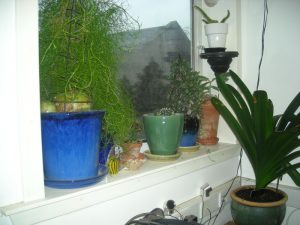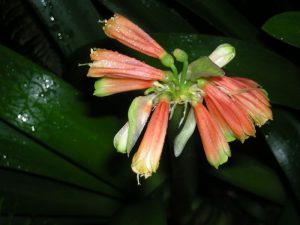Pete Brownless, nursery supervisor for almost two decades, is also the author of the Greenfingers column in our quarterly magazine The Botanics. Pete has been writing this column focusing on plants he grows and knows from personal experience. He’s a plantsman who crams his own garden at home with plants from all climatic and altitudinal zones of the world, many of which he has collected personally on expeditions to South America, Japan, China and mainland Europe right to the land bridge with Asia.
By this you will understand how his north facing windowsill in the office (which we have shared for too many years), is populated with an eclectic range of potted plants. Even the pots themselves have style.
In the attached image from left to right can be seen:
- Bowiea volubillis, a member of the Hyacinthaceae family. The succulent, scaly, green bulb sits on the soil surface supporting stems that feel distinctly cool to the touch. All green parts of the plant photosynthesise.
- Gymnocalycium mihanovichii c.v. with no chlorophyll grafted onto Hylocereus sp. rootstock where it resembles a designer styled hat. These appear in a selection of chlorophyll reduced or missing colours; yellow, red, burgundy, white, black, often seen in garden centres as a novelty plant.
- Lophopora williamsii. Of mid-green insignificant appearance, but what a background. Known as Peyote, the Mexican and Arizonian Indians used to chew the plant to induce visions for medicinal and ceremonial occasions.
- Ceropegia linearis. A second plant in the collection with thin trailing stems needing a form of support. If left to grow along the ground, miniature tubers will form at the nodes. These can be grown on as propagules. The distinctive triangular shaped leaves have white marbled veining, waxy to the feel.
- Rechsteineria leucotricha (syn Sinningia canescens). A Brazilian Gesneriad with a semi-buried tuber. The shoots and leaves are covered in minute white hairs giving a soft downy look to the plant. Flowers are orange and loaded with nectar, which has a habit of dripping out of the tubular calyx.
- Aporocactus flagelliformis, the ‘rat tail cacti’, with shoots that can reach 1.2metres in length. Ephipytic in the high plateaus of Mexico where the red flowers are pollinated by hummingbirds.
-
Clivia miniata, which has long been subjected to an irregular drought experiment; we all forget to water it when Pete is away. Despite this it flowers annually in April. Members of the genera detest root disturbance and will accept dust dry conditions and shade. Clivia species, hybrids and cultivars can be seen in the north side of the Temperate Lands house growing beneath the raised walkway. C. gardenii is in bloom now.


